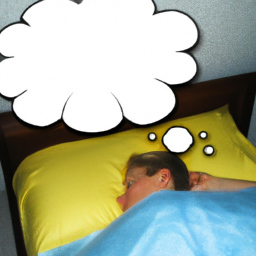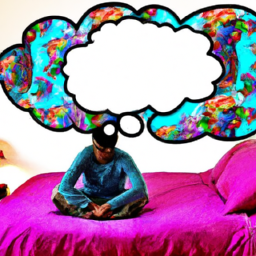Have you ever imagined the ability to control your dreams? Imagine flying through the air, exploring new places, or meeting your favorite celebrities, all while you sleep. I have good news for you – this is possible, and you can make it happen in just one night.
It’s called lucid dreaming, and it’s a state of consciousness where you become aware that you’re dreaming and can actively control the content of your dreams. It’s a skill that can be learned, and with practice, can lead to some of the most unforgettable and exciting dream experiences you’ve ever had.
So, if you’re ready to take control of your dreams and unlock a whole new world of possibilities, then let’s get started.
Key Takeaways
- Lucid dreaming is a state of consciousness where you become aware that you’re dreaming and can actively control the content of your dreams.
- Techniques like the Wake-Back-to-Bed technique, Mnemonic Induction of Lucid Dreams (MILD), and Wake-Induced Lucid Dreams (WILD) can help achieve lucid dreaming.
- Staying lucid is crucial to controlling and fully experiencing your dream, which can be maintained by repeating a mantra like ‘I’m aware I’m dreaming’ or performing reality checks.
- Exploring your dreams can come with its own set of challenges, but with practice, you can gain insights and transform negative experiences into positive ones.
Understanding Lucid Dreaming
If you want to control your dreams in one night, it’s crucial to understand what lucid dreaming is and how it works.
Lucid dreaming refers to the state of being aware that you’re dreaming while you’re still in the dream. This allows you to take control of your dream and manipulate it to your liking. You can make anything happen, from flying to meeting your favorite fictional characters.
To achieve lucid dreaming, you need to be able to recognize when you’re dreaming. There are a few techniques that can help with this, such as reality testing and dream journaling.
Reality testing involves regularly checking whether you’re dreaming or not during your waking hours, which trains your brain to do the same when you’re asleep. Dream journaling involves writing down your dreams as soon as you wake up, which helps you remember them better and identify patterns.
By understanding the basics of lucid dreaming and practicing techniques to achieve it, you can prepare your mind for a night of dream control.
Preparing Your Mind
First, before you drift off to sleep, it’s important to clear your mind like sweeping away leaves from a path. Here are four things I do to prepare my mind for lucid dreaming:
-
I take a few deep breaths and focus on relaxing my body, starting from my toes and working my way up to my head.
-
I visualize myself in a peaceful place, like a beach or a forest, and imagine all my worries floating away like clouds.
-
I repeat a mantra or affirmation to myself, like "I’m in control of my dreams"or "I’ll have a lucid dream tonight."
-
I set a clear intention for what I want to do in my lucid dream, whether it’s flying, exploring a new place, or meeting a specific person.
By preparing my mind in this way, I find that I’m more likely to have a lucid dream and be able to control it.
Now, let’s move on to creating the right sleep environment.
Creating the Right Sleep Environment
To optimize my chances of lucid dreaming, it’s crucial for me to craft a comfortable sleep environment that promotes relaxation.
Firstly, I need to ensure that my bedroom is free from any distractions that might interrupt my sleep. This means switching off my phone, turning off the television, and ensuring that there is no bright light shining into the room.
Next, I need to make sure that my bed is comfortable, and that the temperature in the room is just right. I find that sleeping in a slightly cooler room helps me to fall asleep faster.
By creating the perfect sleep environment, I’m setting myself up for success when it comes to inducing a lucid dream.
Inducing a Lucid Dream
I want to share some techniques that’ve helped me induce lucid dreams.
The Wake-Back-to-Bed Technique involves waking up after 5-6 hours of sleep and then going back to bed, while maintaining awareness to enter a lucid dream.
Another method is the Mnemonic Induction of Lucid Dreams (MILD), which involves repeating a phrase or affirmation to yourself before falling asleep to increase the chance of having a lucid dream.
Lastly, Wake-Induced Lucid Dreams (WILD) involve staying aware while transitioning from wakefulness to sleep, allowing you to enter a lucid dream directly.
Wake-Back-to-Bed Technique
Interestingly, studies have shown that using the Wake-Back-to-Bed technique can increase the likelihood of having a lucid dream by up to 35%. This technique involves waking up after 4-6 hours of sleep, staying awake for 10-30 minutes, and then going back to sleep. During this waking period, it’s a good idea to engage in relaxing activities such as reading or meditating. This technique works because it helps you achieve the right balance of consciousness and sleep, making it easier to enter a lucid dream state.
To better understand how the Wake-Back-to-Bed technique works, here’s a table that breaks down the different stages of sleep and how they relate to lucid dreaming:
| Sleep Stage | Description | Relationship to Lucid Dreaming |
|---|---|---|
| Stage 1 | Light sleep, easily awakened | Not conducive to lucid dreaming |
| Stage 2 | Deeper sleep, brain activity slows | Not conducive to lucid dreaming |
| Stage 3 | Deep sleep, slow brain waves | Not conducive to lucid dreaming |
| Stage 4 | Deepest sleep, difficult to awaken | Not conducive to lucid dreaming |
| REM Sleep | Rapid Eye Movement, dreaming occurs | Most conducive to lucid dreaming |
As you can see, REM sleep is where most lucid dreaming occurs. By using the Wake-Back-to-Bed technique, you can increase your chances of waking up during a REM sleep cycle and enter a lucid dream state. Next, let’s explore another technique for inducing lucid dreams: mnemonic induction of lucid dreams (MILD).
Mnemonic Induction of Lucid Dreams (MILD)
Get ready to learn about a fun and effective technique for inducing lucid dreams: MILD. This method involves creating a mental reminder or ‘mnemonic’ that will prompt you to recognize that you are dreaming while you are in the dream state. Here are the steps to follow:
-
Set your intention to have a lucid dream before going to bed.
-
When you wake up in the middle of the night, recall your dream as vividly as possible.
-
Repeat a phrase or mantra to yourself, such as ‘I’ll realize I’m dreaming’ or ‘I’m aware that I’m dreaming.’
By consistently using this technique, you can train your brain to recognize dream signs and increase your chances of becoming lucid in your dreams. With practice, you may even be able to have lucid dreams without waking up in the middle of the night.
Now, let’s move on to the next technique for inducing lucid dreams: wake-induced lucid dreams (WILD).
Wake-Induced Lucid Dreams (WILD)
After trying the MILD method for a while, I wanted to explore other ways to control my dreams. That’s when I came across Wake-Induced Lucid Dreams (WILD).
Unlike MILD which involves setting intentions and using a mnemonic technique, WILD is a more direct approach to lucid dreaming. With WILD, the aim is to go directly from a waking state to a dreaming state while staying conscious throughout the transition.
This can be achieved by lying down in a comfortable position, relaxing your body, and staying completely still while focusing on your breath. You may start to feel sensations such as vibrations or buzzing, and eventually, you will enter a dream state while being fully aware that you are dreaming.
WILD can be a bit challenging at first, but with practice, it can be a powerful tool for controlling your dreams.
Now that you have mastered the art of lucid dreaming using WILD, it’s time to focus on staying lucid. It’s not enough to simply realize that you are dreaming; you need to stay in control of the dream and avoid getting too excited or overwhelmed.
In the next section, we’ll explore some tips and techniques for staying lucid and making the most out of your lucid dreaming experience.
Staying Lucid
Staying lucid is crucial to controlling and fully experiencing your dream. Once you realize you are dreaming, ground yourself by touching objects or looking at your hands. Stay calm and focused to avoid waking up.
One technique to maintain lucidity is to repeat a mantra like "I’m aware I’m dreaming"or perform reality checks like pushing your finger through your hand. By remaining present and conscious in your dream, you can control its direction and uncover deeper meanings.
With practice, you can explore your dreams and gain insights.
Exploring Your Dreams
When exploring your dreams, it’s fascinating to know that studies have shown that people who practice lucid dreaming can experience a decrease in nightmares and an increase in positive emotions during their waking hours. This is because lucid dreaming allows you to take control of your dreams and transform negative experiences into positive ones.
For example, if you are having a nightmare, you can use lucid dreaming techniques to change the outcome of the dream and turn it into a positive experience. However, exploring your dreams can also come with its own set of challenges. Overcoming common obstacles such as difficulty in achieving lucidity, maintaining lucidity, and recalling dreams can be frustrating.
But with persistence and practice, you can develop the skills necessary to master lucid dreaming and unlock the full potential of your dreams.
Overcoming Common Obstacles
To truly unlock the potential of lucid dreaming, you’ll need to persistently work on overcoming common obstacles like difficulty achieving lucidity and recalling dreams. Here are some tips to help you overcome those obstacles:
-
Keep a dream journal next to your bed and write down your dreams as soon as you wake up. This will help you remember more details about your dreams and improve your dream recall.
-
Practice reality checks throughout the day. Ask yourself if you’re dreaming and look for signs that you’re in a dream, such as being able to fly or having superpowers. This will help train your brain to recognize when you’re dreaming.
-
Use affirmations before bed, such as "I’ll have a lucid dream tonight"or "I’ll remember my dreams."This can help program your subconscious mind to focus on lucid dreaming and dream recall.
-
Try different techniques for inducing lucid dreams, such as the Wake Induced Lucid Dream (WILD) technique or the Mnemonic Induced Lucid Dream (MILD) technique. Experiment with different techniques to find what works best for you.
With these tips, you can start to overcome common obstacles and increase your chances of having a lucid dream. In the next section, we’ll explore ways to enhance your dream life even further.
Enhancing Your Dream Life
I’ve found that enhancing my dream life has been a fun and exciting journey. Practicing lucid dreaming has allowed me to take control of my dreams and explore my subconscious mind.
Incorporating visualization has also been helpful in manifesting specific dreams or goals. Experimenting with different techniques has kept me engaged and motivated to continue improving my dream life.
Practicing Lucid Dreaming
Practicing lucid dreaming can be difficult, but with consistent effort and the use of reality checks, it’s possible to become skilled at controlling your dreams in a short amount of time.
Reality checks are simple actions you can perform throughout the day to determine whether you’re awake or asleep. For example, you could try pushing your finger through your palm or counting your fingers. By doing these checks regularly, you’ll start to do them in your dreams as well, which will help you realize that you’re dreaming and take control.
In addition to reality checks, incorporating visualization techniques can also help with lucid dreaming. Before going to bed, visualize yourself becoming lucid in a dream and imagine what you’d do if you were in control. This can help prepare your mind for the experience and increase the likelihood of achieving a lucid dream.
With practice and dedication, lucid dreaming can become a regular part of your dream life, allowing you to explore and control your dreams in ways you never thought possible.
Incorporating Visualization
By visualizing myself becoming lucid in a dream before bed, I can increase my chances of experiencing the excitement and freedom of controlling my dream world. I imagine myself recognizing a dream sign and realizing that I’m in a dream. I visualize myself feeling the rush of excitement and confidence as I become aware of my lucid state. This visualization can help me set an intention to have a lucid dream and remember to do a reality check when I see a dream sign.
Once I’ve incorporated visualization into my lucid dreaming practice, I can begin experimenting with different techniques to increase my chances of becoming lucid in a dream. This may include keeping a dream journal, practicing reality checks throughout the day, and using supplements such as melatonin or other lucid dreaming supplements.
By combining these techniques with visualization, I can develop a strong foundation for lucid dreaming and increase my chances of having a lucid dream tonight.
Experimenting with Different Techniques
Now that you’ve incorporated visualization into your lucid dreaming practice, it’s time to explore different techniques to increase the likelihood of becoming lucid in a dream. One technique that many people find helpful is reality testing. This involves checking throughout the day whether you are dreaming or not. You can do this by looking at a clock or text, looking away, and then looking back to see if the time or words have changed. In a dream, these things often change or become nonsensical. By regularly checking if you are dreaming during waking hours, you train your brain to do the same in your dreams.
Another technique is to set an intention before going to sleep. This can be as simple as repeating to yourself, "I will become lucid in my dreams tonight."You can also visualize yourself becoming lucid and what you will do once you are in control of the dream. This helps to focus your mind and increase the likelihood of becoming lucid. It’s important to experiment with different techniques to see what works best for you. Keep a dream journal to track your progress and any patterns that emerge.
Now that you have a range of techniques to try, it’s time to start applying lucid dreaming to your waking life. By using the skills you’ve developed in your dreams, you can become more aware and intentional in your daily life. You may find that you have more control over your thoughts, emotions, and actions. Practice mindfulness and self-reflection to continue developing your awareness and understanding of your inner world.
Applying Lucid Dreaming to Real Life
Utilizing lucid dreaming can enhance one’s ability to problem-solve and tap into their creativity in waking life. When I’m able to control my dreams, I can practice scenarios that I may face in real life.
For example, if I have a big presentation coming up, I can visualize myself delivering it flawlessly in my dream. This not only helps me feel more confident, but it also allows me to work out any potential problems or obstacles beforehand.
In addition, lucid dreaming can also help me tap into my creativity. I can use my dream state to brainstorm ideas for a project or come up with new solutions to problems I may be facing. By exploring my imagination in this way, I can unlock new ideas and perspectives that I may not have considered before.
This is why utilizing lucid dreaming can be a valuable tool for personal growth and development.
Four ways lucid dreaming can enhance problem-solving and creativity:
- Practicing scenarios that may be encountered in real life
- Working out potential problems or obstacles ahead of time
- Brainstorming new ideas and solutions
- Unlocking new perspectives and ways of thinking
Frequently Asked Questions
Can anyone learn how to lucid dream?
Yes, I believe anyone can learn how to lucid dream. It takes practice and patience, but with techniques such as reality checks and keeping a dream journal, you can increase your chances of becoming aware and in control of your dreams.
Are there any negative side effects of lucid dreaming?
I haven’t experienced any negative side effects from lucid dreaming. However, some people report feeling tired or experiencing sleep disturbances. It’s important to practice good sleep hygiene and not rely solely on lucid dreaming for restful sleep.
Is it possible to have a lucid dream without intending to?
Dreams are like a river, sometimes calm and sometimes wild. As a lucid dreamer, I’ve found that it’s possible to navigate these waters without intending to. It just takes practice and a willingness to let go.
Can lucid dreaming be used to overcome nightmares?
Yes, I’ve found that lucid dreaming can be a powerful tool to overcome nightmares. By recognizing I’m in a dream, I can take control and change the scenario. It’s not always easy, but it’s worth practicing.
How long does it take to become proficient at lucid dreaming?
Becoming proficient at lucid dreaming varies for each individual. It takes practice and patience, but once achieved, can lead to incredible dream experiences and personal growth.
Conclusion
In conclusion, lucid dreaming is a fascinating and powerful tool that anyone can learn to use. By preparing your mind, creating the right sleep environment, and practicing induction techniques, you can take control of your dreams and explore the limitless possibilities of your own subconscious.
Think of your mind as a vast ocean, with lucid dreaming as your boat. With the right tools and techniques, you can navigate the depths of your own mind and discover new insights, overcome fears, and even enhance your waking life.
So, set sail on the sea of your dreams, and see where your mind can take you. The possibilities are endless.









